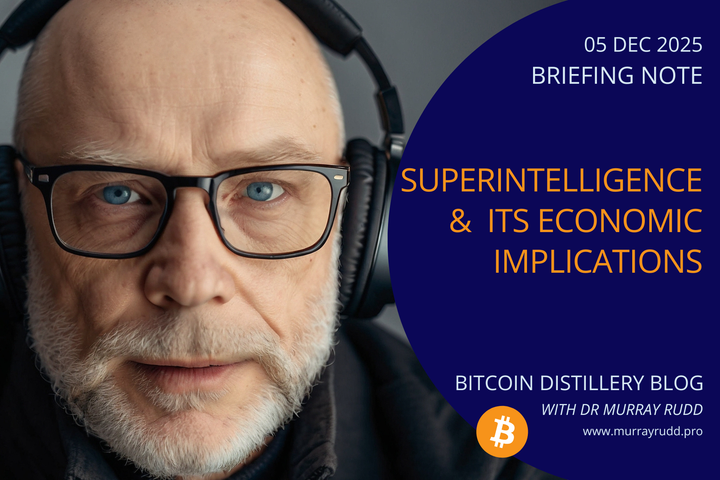AI Scale, Compute Scarcity, and the Next Wave of Platform Competition
The September 26, 2025 episode of the Peter H. Diamandis Podcast features Brian Elliott, Emad Mostaque, and Dave Blundin analyzing whether current AI momentum reflects substance or speculation.

- My 'briefing notes' summarize the content of podcast episodes; they do not reflect my own views.
- They contain (1) a summary of podcast content, (2) potential information gaps, and (3) some speculative views on wider Bitcoin implications.
- Pay attention to broadcast dates (I often summarize older episodes)
- Some episodes I summarize may be sponsored: don't trust, verify, if the information you are looking for is to be used for decision-making.
Summary
The September 26, 2025 episode of the Peter H. Diamandis Podcast features Brian Elliott, Emad Mostaque, and Dave Blundin analyzing whether current AI momentum reflects substance or speculation. The speakers argue that compute, power, and distribution govern near-term outcomes as benchmarks saturate and agentic tooling moves toward deployment. They also surface second-order effects in labor, education, robotics, finance, and health that require coordinated responses from firms and policymakers.
Take-Home Messages
- Compute and power set the ceiling: Capability growth is constrained by GPUs, interconnects, and multi-gigawatt siting rather than sentiment.
- Distribution outruns small model gaps: OS integration and product embedding can beat marginal quality advantages on leaderboards.
- Measurement must evolve: Saturated public tests demand longitudinal, task-grounded evaluations to guide capital and safety.
- Agents need guardrails: Verification, observability, and rollback are prerequisites for enterprise-scale automation.
- Second-order shifts matter: Labor mix, credential value, robotics deployment, tokenized markets, and health validation will drive policy choices.
Overview
Brian Elliott rejects the “AI bubble” narrative and ties rising capability to tangible spending on GPUs, interconnects, and data-center campuses. He argues that physical constraints, not sentiment, cap progress over the next several product cycles. This lens moves attention from headlines to build times, grid access, and thermal engineering.
Emad Mostaque emphasizes that once systems clear a performance floor, distribution dominates competitive outcomes. He notes that OS placement, default settings, and product bundling can overwhelm small quality differences. As a result, leadership turns on reach, switching costs, and integration depth.
Dave Blundin highlights benchmark saturation and the risk of “bench-maxing” that obscures real-world fitness. He urges evaluation that tracks longitudinal task performance, robustness, and operator workload rather than single-shot scores. That shift would improve capital allocation and reduce brittle deployments.
Across applications, the speakers describe agentic software development, robotics, tokenized markets, and health uses moving from demo to early production. Elliott warns that verification and rollback must scale with automation to avoid cascading errors. Mostaque and Blundin add that universities face a credential value challenge as employers prioritize demonstrable skill and portfolio evidence.
Stakeholder Perspectives
- AI labs and hyperscalers: Secure GPUs, interconnect density, and siting while hedging power with on-site generation and long-term offtake.
- Enterprises: Pilot agentic workflows but require verification pipelines, audit trails, and liability clarity before broad rollout.
- Energy utilities and grid operators: Plan capacity expansions and reliability safeguards as AI campuses request firm, high-availability load.
- Regulators and market supervisors: Update disclosure, custody, and surveillance standards for tokenized issuance and continuous trading.
- Universities and training providers: Rebuild credential value by integrating hands-on competencies and verifiable skill assessments.
Implications and Future Outlook
Physical bottlenecks in compute and power will determine AI deployment speed and regional winners. Jurisdictions that align permits, interconnects, and reliable generation will attract the highest-value campuses. Slow movers will face opportunity costs and higher prices for imported capability.
Measurement will evolve from leaderboard snapshots to longitudinal, task-anchored evaluation. Firms that invest in robust testing and observability will convert pilot gains into durable productivity. Those that chase headline scores risk fragile systems, regulatory scrutiny, and remediation costs.
Agentic development expands both productivity and operational risk surfaces. Enterprises that pair automation with verification and rapid rollback will scale faster and safer. Education and workforce agencies will need targeted reskilling to mitigate uneven impacts from adoption choices.
Some Key Information Gaps
- How quickly can GPU manufacturing and interconnect capacity expand to meet model training and inference demand? Compute scarcity sets system-wide ceilings on capability and access, so credible timelines guide industrial planning and investment.
- What mix of solar, storage, and nuclear is feasible on data-center timelines cited by major labs? Energy supply determines deployment speed and competitiveness, linking infrastructure policy to societal benefits.
- What new benchmarks can resist overfitting and reflect real-world task performance across time? Measurement quality shapes capital allocation and safety, making better evaluation a cross-sector priority.
- What verification frameworks keep agentic code generation safe for enterprise-scale releases? Reliability and liability control govern adoption, and practical verification supports regulation and scale.
- What disclosures and real-time attestations should govern tokenized equity issuance and trading? Clear rules enable inclusion and liquidity while protecting investors and integrating with existing market infrastructure.
Broader Implications for Bitcoin
AI–Power Competition and Bitcoin Mining
AI data-center demand will intensify competition for firm power, affecting siting, pricing, and curtailment contracts relevant to Bitcoin mining. Regions that build reliable generation and flexible load programs may see closer integration between miners and AI campuses. Over a 3–5 year horizon, coordinated grid services and new tariff designs could reward miners that provide fast-ramping flexibility alongside steady baseload buyers.
Capital Allocation and Industrial Policy
Large-scale AI buildouts will channel public and private capital toward transmission, storage, and new generation, reshaping energy markets where miners operate. Policymakers may prioritize projects with dual benefits for digital industries and grid resilience, changing the economics of behind-the-meter mining. This dynamic could accelerate long-term contracts and hybrid campuses that co-optimize compute, heat reuse, and ancillary services.
Verification Norms Spill Over to Bitcoin Infrastructure
Enterprise demand for rigorous AI verification will raise expectations for automation, auditability, and rollback across adjacent digital systems. Bitcoin service providers - exchanges, custodians, and wallet platforms - may face stronger pressures to formalize agent-safe workflows and verifiable controls. Over time, shared assurance frameworks could improve incident response and reduce correlated failure risks in market infrastructure.
24/7 Markets and Tokenized Settlement Expectations
Normalization of tokenized instruments and continuous trading will acclimate regulators and investors to round-the-clock market operations. Expectations for instant settlement and transparent attestations could spill into Bitcoin market plumbing, from proof-of-reserve cadence to on-chain disclosure standards. The result may be tighter integration between traditional venues and Bitcoin rails with clearer supervisory touchpoints.
Workforce Shifts and Bitcoin Adoption Patterns
AI-driven changes in job composition and credential value will alter savings behavior and risk tolerance across cohorts. Households exposed to automation may diversify toward self-custodied, portable assets, while employers experiment with Bitcoin-denominated incentives in talent-competitive regions. These shifts could influence transaction patterns on the base layer and the demand for high-assurance custody.



Comments ()